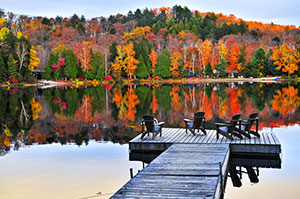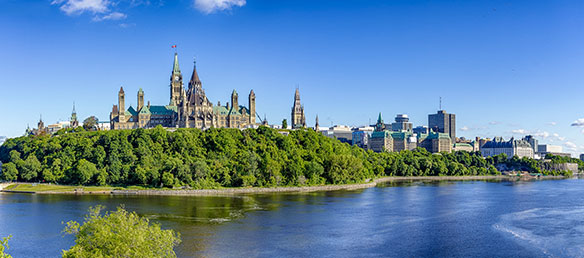
Ontario: It’s there for agents to discover

Beth Potter, President & CEO of the Tourism Industry Association of Ontario (TIAO), tells Canadian Travel Press this week that: “I think there is a great opportunity for Canadian agents and operators to package new itineraries for the local markets.”
Let’s start with the obvious question: what is TIAO’s reaction to Ontario’s 2020 Budget? What are you hearing from your members, in terms of their reaction (or reactions) about the Budget – are they satisfied?
The provincial budget was a step in the right direction. Minister Phillips acknowledged the importance of the tourism industry to the provincial economy, and also acknowledged that Ontario’s economic recovery from Covid-19 won’t be complete until the tourism industry has recovered.

Beth Potter
This acknowledgement is important as it keeps the doors open for us to work collaboratively with the government to support tourism businesses.
In meetings following the budget with both Minister MacLeod and the Premier, both delivered the message to tourism business owners that they will continue to support the recovery of our industry.
Can you talk about specifics in the 2020 Budget? What are the initiatives that will help the industry?
Support for Tourism and Hospitality Businesses and Workers
- Investing $100 million over two years for the Community Building Fund to support community tourism, cultural and sport organizations. Funding support would be available to not-for-profit organizations and municipalities, and the program will be delivered by the Ontario Trillium Foundation with two streams:
o Supports for local community tourism, heritage and culture not-for-profits, such as community museums, local theatres, fairs and cultural institutions, to help sustain their operations in the short term and create new attractions, experiences and events; and
o Funding for municipalities and not-for-profit sport and recreation organizations to make investments in infrastructure rehabilitation and renovation, in order to meet public health protocols and local community needs.
- One-time emergency funding of $25 million for Ontario’s arts institutions to help cover operating losses incurred as a result of COVID-19.
- Investing $180.5 million over 3 years for workers in the tourism and hospitality sector and others most affected by the pandemic to training and jobs. This includes a skilled trades strategy, an additional $100 million of dedicated investments through Employment Ontario for skills training, a redesigned Second Career program and $59.5 million to acquire in-demand skills.
- Providing $4.4 million to the Travel Industry Council of Ontario to support its operations and waiving its oversight fee this fiscal year.
- Freezing beer tax rates until March 1, 2022. The government is also proposing to retroactively cancel the increase in wine basic tax rates legislated to occur on June 1, 2020.
- 2021 – Year of the Staycation
- The government is exploring ways to provide Ontario residents with support of up to 20 per cent for eligible Ontario tourism expenses to encourage them to discover Ontario in 2021 when public health experts advise it is safe to do so.
o The government is setting aside $150 million for this initiative and will be consulting with stakeholders about the details. An update on this temporary support measure will be announced at a later date.
The government is upgrading Ontario Parks facilities and services to support increased visitation and provide an additional boost to the recovery of the outdoor tourism sector.
This will include:
- Investing one-time funding of $6 million to electrify more campsites, and revitalize and expand the number of roofed accommodations;
- Providing online delivery to supplement Discovery Education programs; and
- Amending the Provincial Parks and Conservation Reserves Act, 2006 to increase fiscal sustainability.
In TIAO’s view, could the provincial government have done more? In what areas do you think it could have done more?
The specific funding programs within the budget are helpful, but not anywhere near what we needed to see. Businesses are suffering huge losses of revenue due to restrictions in being able to open or being opened at a reduced capacity. So, more is needed to support business liquidity and not add to the large debt load.
One of the real challenges is for seasonal businesses that haven’t been open since 2019.
Take for example an outdoor concert venue.
Concerts have been on the restricted list since the original State of Emergency was declared in March. The owners/operators are now heading into the winter months, still not allowed to open, and with no revenues from the summer months to get through to next spring.
In this case, there is no rent, but a mortgage and the financial support packages either didn’t apply to this business or what was available has run out. This concert venue may be around for the 2021 season.
Following up on this. I’m wondering what kind of conversations TIAO will be having with Minister of Heritage, Sport, Tourism and Culture, Lisa McLeod going forward. And I’m also wondering how helpful the Minister has been in assisting the province’s tourism and hospitality industry during these difficult times?
Minister MacLeod has been a true Tourism Champion throughout the pandemic. She immediately began working with industry, convening advisory committees that funneled real time information to her.
She has been a loud voice on the Jobs & Recovery Committee, and the Premier tells us that she is a strong advocate for the industry at the Cabinet table. She also spent
11 weeks this summer touring the province in an effort to demonstrate that you can travel during a pandemic and do it safely.
We work very closely with her and her team. She has been incredible accessible – usually starting her day with stakeholder calls at 7:30am.
Backing up a bit, can you give me a bit of an overview of where things are at for Ontario’s tourism and hospitality industry right now? How challenged is it?
Before the pandemic, Tourism in Ontario represented more than 400,000 workers and over 200,000 businesses. Annually, the sector contributed $36 billion to the GDP and $5 billion to the province through tax revenue.
In 2019, almost 65% of businesses saw an increase in their revenues, 5% experienced an increase of 50% in their sales and revenues. 1 in 4 of all new jobs in the economy were in the tourism sector, equalling 5.5% of all jobs in Ontario. Since the pandemic began, 86% of businesses have suffered a drop in their revenue, on average down by 68%. Most businesses in the sector have lost over half their workforce. 71% of businesses have had to access government support such as the Canada Emergency Wage Subsidy, and 65% say that they would have been permanently closed had it not been for government support.
Looking at international travel, the World Travel & Tourism Council predicts that by the end of 2020 international travel will be down 73%. Add to that domestic travel which is down about 64%, and the result is 1.6 million jobs in Canada are at risk.
That said, what are the next steps for TIAO and the industry? What does it need to survive and thrive going forward?
 I’ve already spoken to the need for financial liquidity support. There is other support in the works. Minister MacLeod recently spoke to her 5-year recovery plan. We expect to see consultations on a draft version by the end of the year, and a full plan early in 2021.
I’ve already spoken to the need for financial liquidity support. There is other support in the works. Minister MacLeod recently spoke to her 5-year recovery plan. We expect to see consultations on a draft version by the end of the year, and a full plan early in 2021.
In the meantime, businesses of all kinds are adapting to a new normal. By that I don’t just mean using PPE and physical distancing, although that has been an important part. Business owners who relied heavily on Americans are now looking more closely at the domestic market. I would encourage all businesses to look at way in which they can shift their business model to take advantage of the domestic market for the near future.
I believe that TIAO has been surveying its members on a regular basis. Can you share some of the intelligence that TIAO has gathered from these surveys? I guess the question is what is the state of the industry in Ontario currently?
We began surveying the industry at the start of the pandemic so that we could understand and track what was happening on the front lines of our industry. We released the results of our 8th survey in October.
In summary, the survey finds that the benchmark McKinsey report underestimated the scale of loss in revenue that tourism businesses are suffering. Whilst the McKinsey report estimated that tourism businesses would suffer a 58% reduction in revenue, our survey shows that in fact the average revenue decline is higher at 69%.
Tourism businesses are operating at reduced or limited capacities, forcing them to lay off staff with continuing worries about cash flow to make payroll and pay fixed costs such as commercial rent, utility payments and servicing existing debt.
The growing threat of a second wave (and perhaps 3rd wave) and a regression into more stringent physical distancing protocols has resulted in nearly half of all business owners feeling pessimistic about their businesses future.
Regionally, Northern Ontario continues to suffer the most, with business owners less optimistic than Ontario businesses generally about the future of the businesses. Due to border closures, Northern Ontario businesses are suffering an even higher decline in revenues in comparison to the rest of Ontario.
Canadian Travel Press’ readers are tour operators and travel agents – the people who build and sell outbound travel packages. Until now, there has been a certain disconnect between Canadian agents/operators and the Canadian domestic tourism industry. Do you see opportunities for your members to work with these agents and operators going forward?
For the next 18 months to 2 years, domestic travel is going to be so important. This past summer, we saw many people travelling to parts of the province that were new to them, trying new experiences. I think there is a great opportunity for Canadian agents and operators to package new itineraries for the local markets.
We are happy to help make this connection.
Last question: Are you optimistic or pessimistic about the future of the industry? Why?
Of course, I’m optimistic!
People have been travelling since time began, and we will again.
It’s in our nature as human beings to want to meet people face to face, to explore and experience new things and places.
There are some things that need to get put in place so that we can restart international travel even while we wait for a vaccine.
For example, we need to get our borders open and testing in place at border crossings.
Airlines and airports are working collaboratively to make these things happen, but we need the support of government as well.
It will take a while, but there is no doubt in my mind that our industry will recover.

